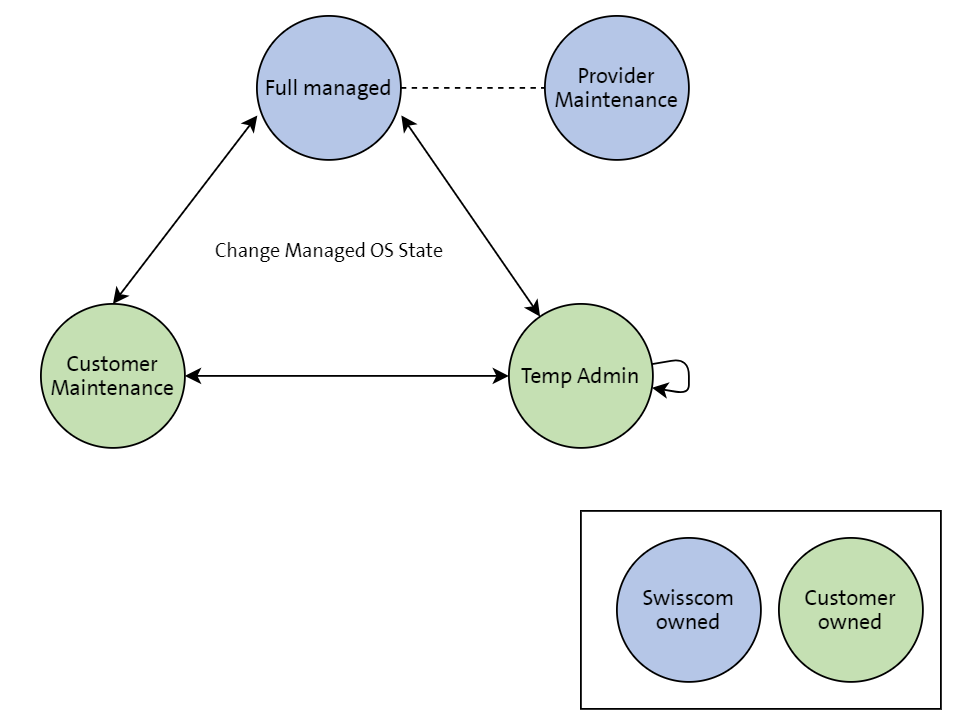Service States
A Swisscom RHEL VM can be in one of the states described in the next sections.
The status diagram for the Swisscom RHEL VM is shown below. The graphic shows the states and state transitions (actions).
The intervals and duration between the transition from Full Managed state to Customer Maintenance state can be limited by Swisscom. A distinction is made between the following states and state transitions:

The individual states differ in the services and functions offered and in the authorizations that you have on the server.
Full Managed state
Elevated privileges: In this state, you have no administration or root privileges granted on the server, the Swisscom operations team will manage your Swisscom RHEL VM.
Service Level Agreement (SLA): The Enterprise Service Cloud service levels and support times apply. The SLAs applies up to and including the operating system level.
Purpose of the state: In this state, Swisscom does the operation of the server up to the top edge of OS. Swisscom ensures the following:
- Patching
- Malware Protection
- SLA on the OS
- Monitoring
- Troubleshooting by Swisscom
- Alarming
You have the privilege to perform the following actions on the server via portal/API:
| Action | Permitted |
|---|---|
| Power On | No |
| Power Off | No |
| Reboot | No |
| Reconfigure (CPU, RAM, Disk) | No |
| Destroy VM | Yes |
| Connect to Remote Console | Yes* |
| Create Snapshot | No |
| Delete Snapshot | Yes |
| Create Backup | Yes |
| Restore | No |
*only with unprivileged user login
Customer Maintenance state
You can change your system from the Full Managed state into the Customer Maintenance state. In this state, the SLAs for the system are suspended and the alarming is temporarily deactivated.
Admin rights: You have no administration rights.
Service Level Agreement (SLA): The Service Level Agreements at OS level are suspended in this state.
Purpose of the state: In this state you can perform certain actions without having to switch to Temp Admin state. E.g., the VM can be restarted in this state. The return to the Full Managed state takes place without the execution of the compliance checks.
Swisscom ensures the following functions:
- Malware Protection
- Troubleshooting by Swisscom (during CH office hours, charges apply)
You have the privilege to perform the following actions on the server via portal/API:
| Action | Permitted |
|---|---|
| Power On | Yes |
| Power Off | Yes |
| Reboot | Yes |
| Reconfigure (CPU, RAM, Disk) | Yes |
| Destroy VM | Yes |
| Connect to Remote Console | Yes* |
| Create Snapshot | Yes |
| Delete Snapshot | Yes |
| Create Backup | Yes |
| Restore | No |
*only with unprivileged user login
Temp Admin state
The Temp Admin state is an enhancement of the Customer Maintenance state. All properties of the Customer Maintenance state also apply in this state. In addition, you receive temporary administration privileges on Operating System level. Also, some additional actions might be available in the portal in this state.
Admin rights: You receive administration privileges on the system.
Service Level Agreement (SLA): The Service Level Agreements at OS level are suspended in this state.
Application purpose of the state: This state is typically used to allow you to setup your own software on the server. Compliance checks are executed after switching back to Full Managed state. These checks can take several minutes depending on the server configuration. The operating system will be patched in this state during the patching window.
Swisscom ensures the following functions:
- Patching
- Malware Protection
- Troubleshooting by Swisscom (during CH office hours, charges apply)
You have the privilege to perform the following actions on the server via portal/API:
| Action | Permitted |
|---|---|
| Power On | Yes |
| Power Off | Yes |
| Reboot | Yes |
| Reconfigure (CPU, RAM, Disk) | Yes |
| Destroy VM | Yes |
| Connect Remote Console | Yes |
| Create Snapshot | Yes |
| Delete Snapshot | Yes |
| Create Backup | Yes |
| Restore | Yes* |
*Restore is only possible if the VM was in Full Managed or Customer Maintenance state at the time of the backup to be restored.
Provider Maintenance state
Admin rights: You have no administration rights.
Service Level Agreement (SLA): The SLAs applies up to and including the operating system level. The maintenance window is regulated within the SLA.
Purpose of the state: In this state, Swisscom can carries out maintenance work on the server. Typically, the OS is patched in this state.
Swisscom ensures the following functions:
- Patching
- Malware Protection
- SLA on the OS
- Monitoring
- Troubleshooting by Swisscom
You have the privilege to perform the following actions on the server via portal/API:
| Action | Permitted |
|---|---|
| Power On | No |
| Power Off | No |
| Reboot | No |
| Reconfigure (CPU, RAM, Disk) | No |
| Destroy VM | Yes |
| Connect to Remote Console | No |
| Create Snapshot | No |
| Delete Snapshot | No |
| Create Backup | No |
| Restore | No |
